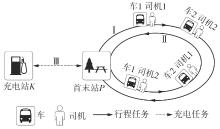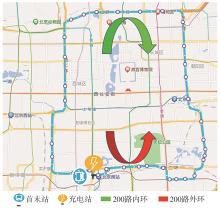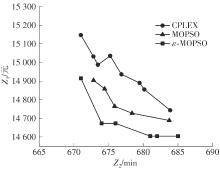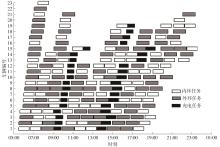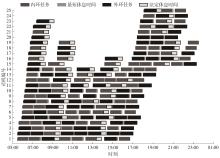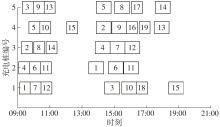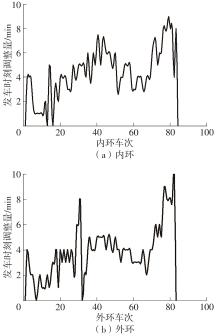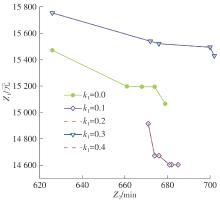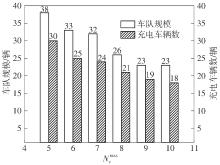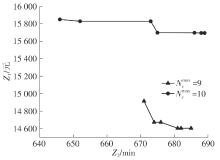Journal of South China University of Technology(Natural Science Edition) ›› 2025, Vol. 53 ›› Issue (6): 91-103.doi: 10.12141/j.issn.1000-565X.240440
• Intelligent Transportation System • Previous Articles Next Articles
Joint Optimization of Loop Line Electric Bus Vehicle Scheduling and Driver Scheduling
HU Baoyu1( ), QI Yue1, JIA Dianjing2, CHENG Guozhu1(
), QI Yue1, JIA Dianjing2, CHENG Guozhu1( )
)
- 1.College of Civil Engineering and Transportation,Northeast Forestry University,Harbin 150040,Heilongjiang,China
2.Liaoning Transportation Affairs Service Center,Shenyang 110003,Liaoning,China
-
Received:2024-09-02Online:2025-06-10Published:2024-12-06 -
Contact:CHENG Guozhu E-mail:hubaoyu@nefu.edu.cn;guozhucheng@nefu.edu.cn -
Supported by:the China Postdoctoral Science Foundation(2023M740558);the Natural Science Foundation of Heilongjiang Province(YQ2022E003)
CLC Number:
Cite this article
HU Baoyu, QI Yue, JIA Dianjing, CHENG Guozhu. Joint Optimization of Loop Line Electric Bus Vehicle Scheduling and Driver Scheduling[J]. Journal of South China University of Technology(Natural Science Edition), 2025, 53(6): 91-103.
share this article
| 1 | FRELING R, HUISMAN D, WAGELMANS P M .Models and algorithms for integration of vehicle and crew scheduling[J].Journal of Scheduling,2003,6:63-85. |
| 2 | SARGUT F Z, ALTUNTAS C, TULAZOGLU D C .Multi-objective integrated acyclic crew rostering and vehicle assignment problem in public bus transportation[J].OR Spectrum,2017,39(4):1071-1096. |
| 3 | STEINZEN I, GINTNER V, SUHL L,et al .A time-space network approach for the integrated vehicle- and crew-scheduling problem with multiple depots[J].Transportation Science,2010,44:367-382. |
| 4 | BOYER V, IBARRA-ROJAS O J, RIOS-SOLIS Y A .Vehicle and crew scheduling for flexible bus transportation systems[J].Transportation Research Part B:Methodological,2018,112:216-229. |
| 5 | HORVÁTH M,KIS T .Computing strong lower and upper bounds for the integrated multiple-depot vehicle and crew scheduling problem with branch-and-price[J].Central European Journal of Operations Research,2017,27:39-67. |
| 6 | 侯彦娥,孔云峰,朱艳芳,等 .公交司机排班问题的混合元启发算法研究[J].交通运输系统工程与信息,2018,18(1):133-138. |
| Hou Yan-e, KONG Yun-feng, ZHU Yan-fang,et al .A hybrid metaheuristic algorithm for the transit bus and driver scheduling problem[J].Journal of Transportation System Engineering and Information Technology,2018,18(1):133-138. | |
| 7 | ANDRADE-MICHEL A, RÍOS-SOLÍS Y A, BOYER V .Vehicle and reliable driver scheduling for public bus transportation systems[J].Transportation Research Part B:Methodological,2021,145:290-301. |
| 8 | KANG L, CHEN S, MENG Q .Bus and driver scheduling with mealtime windows for a single public bus route [J].Transportation Research Part C:Emerging Technologies,2019,101:145-160. |
| 9 | 刘昊翔,吴啊峰,龙建成,等 .基于列生成启发式的单线电动公交车与司机整合调度优化[J].交通运输系统工程与信息,2021,21(4):211-220. |
| LIU Hao-xiang, WU A-feng, LONG Jian-cheng,et al .Column generation-based heuristic approach for electric bus and driver scheduling on single bus lines[J].Journal of Transportation System Engineering and Information Technology,2021,21(4):211-220. | |
| 10 | 孔云峰 .多目标公交车辆与司机调度问题元启发算法设计[J].交通信息与安全,2021,39(3):50-59. |
| KONG Yunfeng .A metaheuristic algorithm for multi-objective transit bus and driver scheduling problems[J].Journal of Transport Information and Safety,2021,39(3):50-59. | |
| 11 | 杨扬 .电动公交车行车计划问题建模与算法研究[D].北京:北京交通大学,2020. |
| 12 | ZHANG A, LI T, ZHENG Y,et al .Mixed electric bus fleet scheduling problem with partial mixed-route and partial recharging[J].International Journal of Sustainable Transportation,2021,16:73-83. |
| 13 | HE Y, LIU Z C, SONG Z Q .Joint optimization of electric bus charging infrastructure,vehicle scheduling,and charging management[J].Transportation Research Part D:Transport and Environment,2023,117:103653/1-23. |
| 14 | SISTIG H M, SAUER D U .Metaheuristic for the integrated electric vehicle and crew scheduling problem [J].Applied Energy,2023,339:120915/1-13. |
| 15 | JIANG Y, HE T .Optimal charging scheduling and management with bus-driver-trip assignment considering mealtime windows for an electric bus line[J].Complex,2022,2022:3087279/1-19. |
| 16 | ZHANG A, LI T, ZHENG Y,et al .Mixed electric bus fleet scheduling problem with partial mixed-route and partial recharging[J].International Journal of Sustainable Transportation,2022,16(1):73-83. |
| 17 | 翁剑成,乔润童,王茂林,等 .考虑场景差异性的混合车型公交调度优化方法[J].交通运输系统工程与信息,2024,24(4):176-187. |
| WENG Jiancheng, QIAO Runtong, WANG Maolin,et al .Optimization method for mixed vehicle bus sche-duling considering scenario differences[J].Journal of Transportation Systems Engineering and Information Technology,2024,24(4):176-187. | |
| 18 | JI J H, BIE Y M, ZENG Z L,et al .Trip energy consumption estimation for electric buses[J].Communications in Transportation Research,2022,2:100069/1-13. |
| 19 | COELLO C A C, LECHUGA M S .MOPSO:A proposal for multiple objective particle swarm optimization[C]∥ Proceedings of the 2002 Congress on Evolutio-nary Computation.Honolulu,HI:IEEE,2002:1051-1056. |
| 20 | TAKAHAMA T, SAKAI S .Constrained optimization by the ε constrained differential evolution with an archive and gradient-based mutation[C]∥ Proceedings of IEEE Congress on Evolutionary Computation.Barcelona:IEEE,2010:1-9. |
| [1] | SU Yuejiang, WEN Huiying, YUAN Minxian, et al. Travel Carbon Emission Prediction Model Based on Resident Attribute Data [J]. Journal of South China University of Technology(Natural Science Edition), 2024, 52(8): 23-33. |
| [2] | YANG Yazao, WENG Tangzheng. Impact of Spatiotemporal Constraints on Active Travel [J]. Journal of South China University of Technology(Natural Science Edition), 2024, 52(2): 113-123. |
| [3] | LU Yiqin, HUANG Chenghai, CHEN Jiarui, et al. Time Sensitive Network Scheduling Method Based on Genetic Algorithm [J]. Journal of South China University of Technology(Natural Science Edition), 2024, 52(2): 1-12. |
| [4] | ZHUANG Yan, DONG Chunjiao, MI Xueyu, et al.. Identification of Accident Black Spots Based on Improved Network Kernel Density and Negative Binomial Regression [J]. Journal of South China University of Technology(Natural Science Edition), 2024, 52(1): 119-126. |
| [5] | ZHAO Xiaomei, HAO Guoyu, NIU Xiaojing, et al.. Traffic Boundary Control Strategy Based on Macroscopic Fundamental Diagram Under Different Rainfall [J]. Journal of South China University of Technology(Natural Science Edition), 2024, 52(1): 72-82. |
| [6] | HU Xinghua, CHEN Xinghui, WANG Ran, et al. Optimization Model of Bus Priority Control Considering Carbon Emissions with Stochastic Characteristics [J]. Journal of South China University of Technology(Natural Science Edition), 2023, 51(10): 160-170. |
| [7] | XU Lunhui, YU Jiaxin, PEI Mingyang, et al. Repositioning Strategy for Ride-Hailing Vehicles Based on Geometric Road Network Structure and Reinforcement Learning [J]. Journal of South China University of Technology(Natural Science Edition), 2023, 51(10): 99-109. |
| [8] | SHEN Yutong, LI Ming, CUI Zhiyong, et al. Study on the Multi-Period Allocation Method of Vehicle Resource in Hybrid Service Mode [J]. Journal of South China University of Technology(Natural Science Edition), 2023, 51(10): 89-98. |
| [9] | WANG Hao, XIE Ning . Coordinated Optimization Model of Arterial Segmented Green Waves Considering the Efficiency of Tram Operation [J]. Journal of South China University of Technology(Natural Science Edition), 2023, 51(1): 95-105. |
| [10] | ZHAO Jiandong, ZHU Dan, LIU Jiaxin. Metro Transfer Passenger Flow Prediction Based on STL-GRU [J]. Journal of South China University of Technology(Natural Science Edition), 2022, 50(5): 22-31. |
| [11] | WU Jiaorong XIE Jinhong WANG Yuqin. The Profiling Method of Instability of Bus Route Operation and Its Application [J]. Journal of South China University of Technology(Natural Science Edition), 2022, 50(2): 15-22. |
| [12] | CHEN Xiaohong, HU Fang . Interval Optimization Model of Signal Control at Intersection Based on Possibility Degree [J]. Journal of South China University of Technology(Natural Science Edition), 2022, 50(10): 29-40. |
| [13] | YU Lijun. Generalized System-Optimal Traffic Assignment with Link Capacity Constraints [J]. Journal of South China University of Technology(Natural Science Edition), 2021, 49(4): 140-148. |
| [14] | YAO Enjian LU Muyang LIU Yuhuan YUAN Ling. Electric Bus Area Driving Plan Preparation Considering Charging Constraints [J]. Journal of South China University of Technology(Natural Science Edition), 2019, 47(9): 68-73. |
| [15] | LIU Zhongbo ZHAO Xiaohui. A Dynamic Allocation and Guidance Model for Parking Spaces with Minimum Total Parking Costs#br# [J]. Journal of South China University of Technology(Natural Science Edition), 2018, 46(9): 92-98. |
| Viewed | ||||||
|
Full text |
|
|||||
|
Abstract |
|
|||||
